Article Information
- Olof Andrén, XueYong Zhao, Thomas Kätterer, Martin Bolinder. 2016.
- Agroecosystem research in Uppsala, Sweden and Naiman, China:Some observations 1987-2014
- Sciences in Cold and Arid Regions, 8(1): 1-8
- http://dx.doi.org/10.3724/SP.J.1226.2016.00001
Article History
- Received: July 10, 2015
- Accepted: September 14, 2015
2. Björklundavägen 3, SE-756 46 Uppsala, Sweden (The consultancy business:Oandren. com);
3. Swedish University of Agricultural Sciences, SE-750 07 Uppsala, Sweden
1 Introduction
The considerable economic development in China during the last 30 years has influenced scientific research in degraded steppe l and scapes in Inner Mongolia,where the Institute of Desert Research,Chinese Academy of Sciences(IDRAS,which in 1999 merged into CAREERI,Cold and Arid Regions Environmental and Engineering Research Institute of the Chinese Academy of Sciences)has a leading position. A booming economy naturally creates financial resources for research, and also a need for solutions to emerging environmental problems generated by the modernization. Possibly the most severe and publicly acknowledged problem concerns the air quality in several major Chinese cities,where wind-blown dust from Inner Mongolia adds to the airborne particle pollution(Yang et al., 2008). This is an area where research and education bodies such as CAREERI make a vital contribution.
In 1987 the Swedish University of Agricultural Sciences(SLU),IDRAS, and SAREC(a Swedish aid/research office)decided on a cooperation project named "Vegetation Dynamics in Semiarid Rangel and in Naiman Banner,Inner Mongolia." The aims were to participate in a conference in Lanzhou,China("International Seminar on the Integrated Control of L and Desertification"),to gain experience of dryl and restoration in China to be used in later aid projects in Africa,to transfer new technology to Naiman Station, and to train Chinese M.Sc. and Ph.D. students for degrees at SLU and Uppsala University.
The Naiman Desertification Research Station in eastern Inner Mongolia(42°58'N,120°44'E,350 m a.s.l.,520 km northeast of Beijing)was established by IDRAS in the Horqin S and y L and area in 1985, and has become a cornerstone for scientific investigations and information processing regarding restoration of s and y l and . Swedish scientists repeatedly visited Naiman for cooperative work in 1988-1994, and during these years Chinese students stayed in Uppsala for Ph.D. or M.Sc. studies and exams.
The first author here,Olof Andrén,was honored with a Professorship for Senior International Scientists at CAREERI 2012-2013,including visits to Naiman. During this period several papers concerning different aspects of dryl and ecology were prepared and submitted(e.g.,Luo et al., 2014), and some of the ideas generated are further developed here,including the use of modeling for calculating effects of different reclamation measures.
This paper summarizes observations and ideas generated during Chinese-Swedish cooperation projects spanning 25 years. First,experiences from s and y l and research within the Chinese-Swedish project during 1988-1994 concerning climate,vegetation,root observations,soil carbon balances,etc. are briefly presented. Second,we give a brief overview of the Introductory Carbon Balance Model(ICBM)concept,gradually developed in Sweden,Kenya, and Canada since the mid-1990s. Finally,we comment on the changes and development from 1994 to the present and give some recommendations for future research.
2 The early yearsFrom the late 1980s into the 1990s,the Naiman Station was gradually exp and ed; in 1988 there was a dormitory with a ping pong table,a building with kitchen and cafeteria,a laboratory building, and not much more(Figure 1). During this period the station was headed by Prof. KangFu Wang,who was very helpful and supported the project with staff and equipment. In the Swedish project,housed in the old facilities,we introduced newly developed computer loggers and installed one for measuring soil temperatures and water content at Sharitala,close to the station, and we also introduced heavy "laptop" PCs,which were used for reading and processing logger data. A weather station was set up at Naiman Station with a Stevenson screen,a rain meter, and an open pan for evaporation monitoring. Root studies were initiated, and new soil corers as well as below-ground observation periscopes were introduced and used. We also set up litter decomposition experiments with fine-mesh nylon bags buried in the field. Photosynthesis studies were made using a portable leaf CO2 exchange meter.
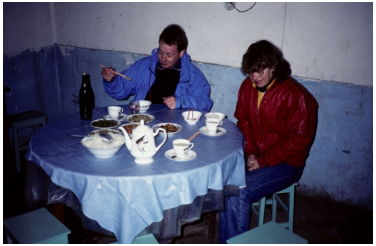 |
| Figure 1 Drs. Roger Pettersson and Lotta Hansson enjoy a cold morning breakfast in the old Naiman cafeteria in spring 1989 |
The research during 1988-1994 resulted in a number of international scientific papers and also M.Sc. and Ph.D. degrees for young Chinese scientists -- Wei Zhang,AiFen Zhao, and XueYong Zhao. For example,vegetation dynamics in degraded steppe were studied(Zhang and Skarpe, 1995),as were root production and dynamics(Hansson et al., 1993,1995). The vegetation studies(Figure 2)in steppe l and scape dominated by Artemisia sp. indicated that only areas recently protected from grazing showed a directional vegetation change. Thus,protection against overgrazing was a key element in restoring the steppe. Root production,including turnover,was studied by a combination of techniques: soil coring,pit digging,mini-rhizotrons(transparent tubes inserted into the soil), and also ingrowth mesh bags. The studies indicated that roots of the dune shrubs Artemisia halodendron and Caragana microphylla both responded to moisture in a similar way with almost no growth during years with dry growing seasons. Annual root production estimates depended on method,with root coring giving low estimates and ingrowth mesh bags and mini-rhizotrons giving higher values,up to 250 g/m2 organic dry mass for each of the species,0-35 cm depth. Methodological problems were thoroughly discussed.
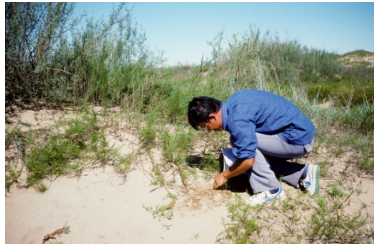 |
| Figure 2 A young Prof. XueYong Zhao examines vegetation close to Naiman Station in 1988 |
Climate influence on litter decomposition was also studied(Andrén et al., 1994),who found that annual average temperatures were fairly similar in Uppsala in central Sweden and Naiman(5℃ and 6.5 ℃,respectively),but there was less rainfall at Naiman(550 and 363 mm,respectively). The litter decomposition rate was fairly similar between the sites,about 50% mass loss after one year, and a very simple decomposition model assuming no activity below 0 ℃ explained as much as 84% of the variance. In parallel with international publication in scientific journals,M.Sc. and Ph.D. theses as well as papers in Chinese were published(not listed here).
However,the pioneering research and methodology development by IDRAS,led by the late Professor ZhenDa Zhu,should not be forgotten here. The Swedish scientists(as well as Japanese,German, and others)working at the Naiman Station learned much about how to combat desert encroachment and the study of dry s and y l and s,including the use of windbreaks,checkerboard patterns of buried straw, and even air seeding of ephemerals on dunes after rain events(e.g.,Zhu and Yang, 1988). This general(not only agro-ecological)scientific research on how to manage and restore steppe/desert was very valuable for the scientists in the Swedish project,which was partly motivated by gaining such knowledge for use in aid projects in Africa.
The SAREC project finished in the mid-1990s and the Swedish participants moved on to other tasks in the Nordic countries and in Africa,using experiences gained in China(e.g.,Andrén et al., 2007). The Chinese participants also moved on to new tasks,with a few notable exceptions: XinMin Liu became a professor and the head of Naiman Station,followed by Professor HaLin Zhao. XueYong Zhao earned a Ph.D. degree at the Chinese Academy of Sciences,after higher studies in Lund,Sweden, and became a professor at CAREERI and the head of Naiman Station after HaLin Zhao.
3 Modern timesIn October 2012,Olof Andrén revisited Naiman Station. The research station,now headed by Prof. XueYong Zhao,had improved considerably since the 1990s. Gradually,new dormitories,meeting and exhibition rooms,as well as laboratory buildings had been erected, and the modern large main building(Figure 3)was built in 2004. This building has high-st and ard hotel-type rooms for scientists,meeting rooms including large-screen video, and a kitchen,dining room, and a moderately sized banquet hall. The building is more than adequate, and the necessary WiFi Internet(also accessible from the guest rooms)is in place. The adjacent exhibition hall is impressive,with a physical model of the station and surroundings,as well as a collection of papers published based on work at the station. A large meeting room is more than sufficient.
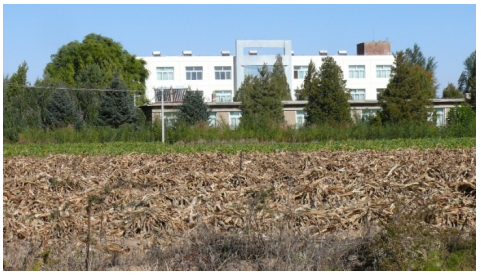 |
| Figure 3 The new main building at Naiman Station, built in 2004. In the foreground are the old living quarters which are now dormitories for students |
There is plenty of laboratory space,both in the new and old laboratories. Sinks,running water,distilled water,etc. are available as well as basic equipment,including weighing scales,ovens,centrifuges, and a Kjeldahl analyzer. Depending on current project needs,more advanced equipment such as C/N analyzers are stationed in the laboratory. Adjoining the station,a new experimental area(incorporated in 2006)is set up among the stabilized s and dunes. The area has concrete walkways,water and electricity, and state-of-the-art equipment,even including a large lysimeter and a root observation window setup. There are also rain shelters and a wind tunnel for studies of,for example,abrasive effects on wind-transported s and on seedlings. Six full-size open-top chambers for CO2 enrichment have been built but are not yet used for enrichment due to the high cost of bottled CO2. Meteorological towers have been erected for measuring wind speed,CO2 gradients,etc.,in cooperation with other institutes home and abroad within the Chinese Ecosystems Research Network(CERN)framework.
The scientific advances during 25 years are of course considerable, and over 1,500 scientific papers have been produced. An increasing proportion is being published in international journals; as many as 480 papers published in 1990-2009 were in journals listed by the Science Citation Index. Although there is not enough room here for listing these,a few examples can be given. Zuo et al.(2012)studied indirect drivers of plant diversity relationships, and the paper gives a comprehensive overview of climate,soil, and vegetation composition in Horqin S and y L and as well as many references to literature based on Naiman research. It is notable that much of the research has its roots in methods introduced during the 1980s Swedish-Chinese project,such as mini-rhizotrons,root observation chambers,litter bags, and principal component analysis of vegetation. However,artificial root exudate studies(Luo et al., 2014),molecular biology-based experiments with selected strains of fungal cellulose decomposers(Dr. ShaoKun Wang,personal communication),as well as several other techniques,were not developed then,but science has moved forward.
In general,besides the general economic development,modernization of agriculture, and urbanization of the Naiman area,including Naiman City,our main observation in 2012 was the major decrease in ground water levels -- more than 10 m between 1979 and 2009(Zhao et al., 2009). Actually,the lakes we swam during the 1990s were in 2012 replaced by maize fields with occasional piston pumps for extracting crude oil. Highly productive,fertilized and irrigated maize has certainly improved local living conditions,but the overuse of groundwater is not sustainable in the long run. On a more positive note,one cannot avoid noticing the successful restoration of the former s and dune l and scape close to the station; where there were moving s and dunes and occasional Artemisia bushes,grazed by clearly undernourished goats,there now is grass cover,pine trees, and soil formation going on at an accelerated rate. The reduced grazing pressure,as well as other remedial measures,clearly has had a beneficial effect during the past decades.
4 Soil carbon modelingSoil carbon and its dynamics has long been recognized as a crucial soil component(e.g.,Tenney and Waksman, 1929),but with the recognition of soils as sources/sinks for the greenhouse gas CO2 there has been a major surge in development in soil carbon modeling. In the restoration of degraded steppe biomes,soil carbon balances are especially crucial since soil carbon levels usually decline with degradation, and restoring soil carbon levels reduces the risk for erosion and increases nutrient and water storage. Soil carbon modeling has a long history; even before computers were available,a two-component dynamic model was presented(Hénin and Dupuis, 1945), and as early as 1998 a review listed 26 soil organic matter/carbon models,now all computer-based(Smith et al., 1998).
Based on earlier models and the experiences before and during the Swedish-Chinese project as well as those from Swedish long-term agricultural field trials,we devised the ICBM soil carbon balance model(Andrén and Kätterer,1997). One may have questioned the need for yet another soil carbon model,but there was a need for a simple model that uses more or less the same central equations as the models already present,but only keeps the core within the model and leaves calculations of drivers outside the actual modeling. Thus,the ICBM model could be analytically solved,with each step transparent to the user,which is crucial for national reporting of soil carbon balances. Due to these advantages,ICBM is currently used for the Swedish reporting of carbon balances to the Intergovernmental Panel on Climate Change(IPCC)(Andrén et al., 2008a). It is important to note when reading this 2008 paper that even though the actual ICBM model is simple(Figure 4),calculations of climatic influence,soil type effects, and how much carbon is input from plants each year can be complex. However,general knowledge concerning climate,plant productivity,etc. can be used to generate model inputs when detailed data are not available, and the actual modeling can be done interactively using an Excel spreadsheet(Andrén et al., 2012).
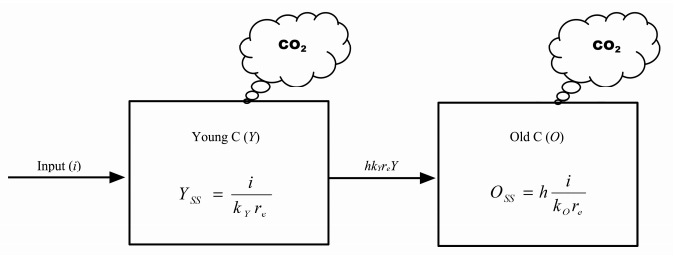 |
| Figure 4 The ICBM model. i = (annual) input, Young C (Y) = young soil carbon, Old C (O) = old soil carbon, kY = fraction of Y that decomposes (per year), kO = fraction of O that decomposes (per year), h = humification coefficient, re = external influence coefficient. The index "SS" denotes the equation for calculating the steady-state value for that pool |
Thus,ICBM was developed as a minimal approach for calculating soil carbon balances in a 30-year perspective. The model has two state variables or pools,"Young"(Y) and "Old"(O)soil carbon(Figure 4). Two pools were considered a minimum,since the model was intended to h and le inputs of different qualities,such as wheat straw vs. farmyard manure. ICBM has five parameters: i,kY,h,kO, and re(Table 1).
| Parameter | Symbol | Typical unit | Effect on soil C mass of increase |
| Input | i | kg/a | Positive |
| Decomp. rate constant for Y | kY | a−1 | Negative |
| Humification coeff. | h | Dimensionless | Positive |
| Decomp. rate constant for O | kO | a−1 | Negative |
| External influence on kY and kO | re | Dimensionless | Negative |
| Note: The "humification coefficient" (h) controls the fraction of Y that enters O and (1−h) then represents the fraction of the outflow from Y that immediately becomes CO2-C. The parameter re summarizes all external influence on the decomposition rates of Y and O. Note that re only affects decomposition rates; re does not influence i or h. | |||
For basic calculations,the only information necessary is a rough estimate of annual carbon input to soil,a coarse measure of residue quality, and some information about climate. If basic weather station data and water-related soil properties are available,more exact projections can be made. Typically the model is used for answering questions such as: If all crop residues are returned to the field,how much will soil carbon have increased after 30 years? If only limited local data are available,rough estimates(climate zone,crop yield,etc.)still make projections possible.
Regardless of the model used,information concerning how climate affects decomposition rates is necessary, and we devised a direct approach for calculating how climate affects decomposition of soil organic matter,corresponding to re in the ICBM. One first step is to calculate the overall climate effects on decomposition rates in the soil using only st and ard soil and meteorological data. We can calculate a simplified climate parameter,re_clim,which uses a st and ard soil(clay loam) and assumes a bare soil to give a pure climatic factor for comparisons. The value for re_clim is calculated from st and ard meteorological data only(daily temperature,rainfall, and reference evapotranspiration),normalized to 1 for the central Swedish climate. Typical values have been calculated for sub-Saharan Africa(Andrén et al., 2007)as well as Canada(Bolinder et al., 2007). A high re_clim indicates conditions leading to rapid decomposition in the soil, and a value of 3 indicates a three times more rapid decomposition than in central Sweden. If a meteorological data set with daily values is available,re_clim is easily calculated using a computer program available from the authors.
Fortunately,there is a massive,high-quality meteorological data set available covering all of mainl and China,encompassing 726 weather stations and ranging from 1951 to 2000(Feng et al., 2004). That comprehensive paper shows that there was a slight increase in summer droughts during 1951-2000,but no dramatic climatic change. Using data from this quality-controlled set(actually the Kailu weather station near Naiman),we calculated re_clim for the period 1953-1998 using a program constructed in the free statistical package R(R Core Team,2013). In Figure 5 it is clear that there was no major trend in air temperature(although possibly a slight increase in annual mean temperature)or precipitation during this period. Reference evapotranspiration,Et0,seems to show less dynamic behavior after 1989,but this may be due to a change in methodology in the open-pan technique. In fact,Feng et al.(2004)recommend against using open-pan data; instead,Et0 can be calculated from other variables,as described in Andrén et al.(2007). However,this would only have a minor influence on the re_clim calculations, and the average re_clim for Naiman,1.2,is only 20% higher than that in central Sweden. This means that the annual decomposition rate is only 20% higher than the low rates in Sweden,which in turn indicates a high potential for carbon sequestration if plant productivity can be increased. In comparison,annual re_clim values as high as 4.3 have been calculated for West African tropical climates(Andrén et al., 2007).
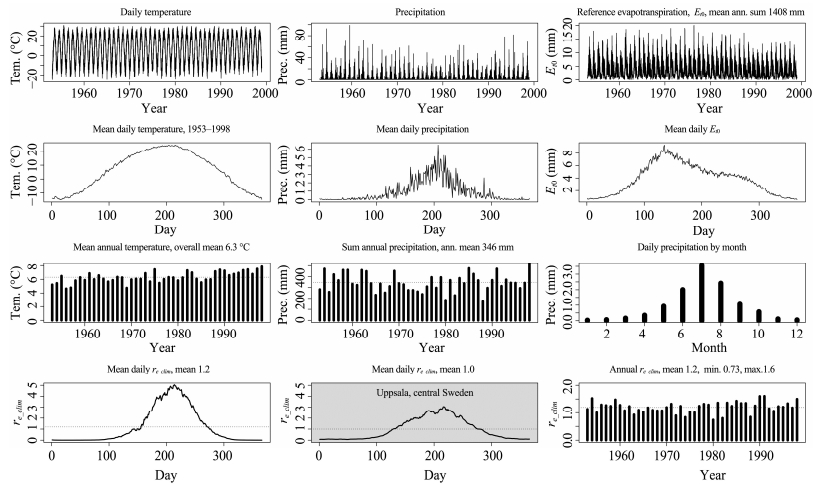 |
| Figure 5 Average climatic variables 1953-1998 from Kailu weather station near Naiman. |
Temperatures(℃) and precipitation and Et0(mm)are given. The daily soil activity factor dynamics(re_clim)is shown and compared with that in Uppsala,central Sweden
5 Recommendations for the future1)To use ICBM or other simple models as a tool to evaluate measures for increasing soil carbon in degraded soils. Note that Inner Mongolia could be a very beneficial site for sequestering soil carbon due to its relatively cool climate leading to low decomposition activity,comparable to that in central Sweden,which has extremely high soil carbon levels. Local adaptation of calculation methods are necessary due to factors such as wind transport of litter,photo-oxidation of surface litter, and wind abrasion(grinding effects through wind-blown s and ). Logical steps would be to calculate the carbon input to the soil from above-ground productivity(using local research results already available),calculate re_clim and re, and use already-available decomposition data to calibrate ICBM. Taken together,this would be a tool for calculating how to best manage soil carbon for restoration of steppe biomes in northern China. Calculating carbon inputs to soil from roots is a difficult but critical step. However,there are estimates and calculator models readily available using allometric constants for a wide range of crops(e.g.,Bolinder et al., 2012).
2)To investigate additional options for steppe restoration and increased productivity. The current methodologies,including windbreaks,checkerboard patterns of wheat or plastic straw dug into soil for dune fixation, and tree planting,are efficient and well proven. However,the final agricultural goal is often cultivation of annuals,mostly maize. This may again lead to soil degradation, and such crops use a lot of water,usually groundwater pumped up for irrigation. One possible alternative could be to plant or seed perennial grasses,which will increase soil carbon,reduce soil cultivation needs, and produce biomass for bioenergy generation and /or animal feed, and possibly also biochar(charcoal)for soil improvement. If properly managed,high yields can be maintained with low environmental impacts. Grass cultivation can of course be combined with tree planting in an agroforestry system,where the grass component would contribute with immediate ground cover,high yields from year 1, and the production of animal feed. We also recommend looking into the effects of adding biochar to the soil. There is considerable interest in adding biochar,which is very resistant to decomposition and is claimed to improve soil properties(Lehmann,2007) and even reduce decomposition rates of native soil organic matter(Carlsson et al., 2012).
3)To improve the quality,presentation, and scientific rigor of Chinese research papers. Twenty-five years ago,scientific papers from China were readily accepted in Western high-status journals due to the shortage of information from this large and important country. Now things are very different. The dem and s on Chinese scientists(including those in training)to publish internationally has resulted in a flood of manuscripts from China. But China is not exotic and therefore a priori interesting anymore; now the science must st and on its own feet. Unfortunately,over the years many Chinese manuscripts suffered from weaknesses of not up to st and ard in format,presentation,choice of subject, and particularly language. Chinese manuscripts still have a high rejection rate(Dr. Bo Söderström,personal communication)even if their overall quality has improved of late. Possibly,there is now a negative bias against manuscripts from China,meaning journal editors and reviewers tend to assume low quality and reject them,sometimes on not very firm grounds. If this observation is correct,there is only one way out: perfection. It is not enough to have somebody "help with the language"; the difference between Chinese and scientific English is enormous, and a word-for-word translation looks very strange. The authors of this paper are not native English speakers(we are,respectively,Swedish,Chinese,German, and Swedish)but have many years of experience in scientific English -- some more than 40 years -- and can therefore appreciate the difficulties in writing in a foreign language. Naturally,the European languages are fairly similar,whereas the move from Chinese to English(or vice versa)is much more difficult.
Therefore,the translation perhaps best is done in two steps. First,the Chinese scientist writes in English using his or her own skills. Then,together with the main author,a co-author or hired consultant with skills in scientific English and ,equally important,good skills within the actual scientific subject matter prepares the manuscript for submission. Common mistakes to be avoided are: submitting letters and other correspondence in poor English -- not processed by an expert; submitting papers that are sloppily formatted and /or not respecting the rules set by the journal(e.g.,writing 3.1415619 instead of 3.1,or using the wrong units); suggesting reviewers who have recently co-published with the authors; or only using new references and ignoring pioneering work,etc.. It is hardly realistic to suggest a change from English to Chinese as the lingua franca of science,but multi-lingual journals and professional cross-translations of Chinese papers to English, and vice versa,would improve interactions and citation rates(Root-Bernstein and Ladle, 2014). Also,high-quality Chinese journals publishing in English should be promoted, and there is a dire need for improved English education in China. Young Chinese scientists switching to English,both when working abroad or in China,have a very steep learning curve in spite of basic training and having successfully passed tests in English. Chinese science and research institutes need to prepare well-managed English-language websites which promote more international exchange,not only Chinese students going out but also Western scientists coming into China,for shorter or longer periods.
4)To improve hypothesis testing through careful experimental design and use of relevant statistical methods. Many of the problems in soil biology research and publishing are not in any way unique to China. "Produce,publish,or perish" is the international norm nowadays, and sometimes quality suffers. Soil biology has advanced but perhaps not as far as it could have. Some observations and suggestions concerning how to improve research st and ards were recently presented by a group of experienced soil biologists(Andrén et al., 2008b). It was stated that the central problem for soil biology -- and much of science in general -- is the difficulty in testing hypotheses in a stringent and rigorous way. The complexity and variability of soils and soil organisms make it difficult to test hypotheses with a clear yes or no answer that is applicable to all areas of the world. There must be a valid way to reject a hypothesis; otherwise we end up with idiosyncratic examples and not much new knowledge. Here we can only briefly reiterate some main points given in the paper of Andrén et al.(2008b). One critical area is experimental design and statistical analysis: high precision and low bias can only be achieved with careful design paired with relevant statistical methods,using positive and negative controls, and avoiding pseudoreplication. There is also often a gap between the theoretical concept addressed and the method used,that must be minimized. For example,fumigating soils to measure "microbial biomass" gives a value,but it is questionable how close this value is related to the true microbial biomass in the soil; thus,the use of this method for rigorous testing of hypotheses regarding microbial biomass is questionable. Another problem,aggravated by the "publish or perish" syndrome,is the gradual drift from reading toward writing in current scientific work. When scientists have to write numerous applications and papers just to stay in business,reading and actually going back to the research roots suffer,in spite of today's easily available .pdf files and computer searches. So much that was published before 1985 is actually still relevant, and the pioneers should also be given due credit. Every soil biologist involved in litter decomposition should read,for example,Tenney and Waksman(1929), and university libraries must also grant access to early papers.
CAREERI and sister institutes in China have an excellent track record and are well positioned to meet the massive current and future challenges concerning dryl and management in China, and it is our hope that this paper can,to some extent,contribute to the efforts needed.
Acknowledgments: This contribution was made possible by a Professorship for Senior International Scientists(Grant No. Y229D91001),kindly granted to Prof. O. Andrén by the Chinese Academy of Sciences,as well as a Speaker invitation to the International Conference on Restoration and Sustainable Use of Desertified L and s held in Tongliao,China in August 2014. The early work(1987-1995)was performed within the project "Vegetation Dynamics in Semiarid Rangel and in Naiman Banner,Inner Mongolia," jointly funded by the Swedish agency SAREC and IDRAS,Chinese Academy of Sciences. A. C. Hansson kindly commented on the manuscript, and we are grateful for receiving formatted meteorological data from Prof. Song Feng,University of Nebraska-Lincoln,Lincoln,Neb. We dedicate this work to the late Professors ZhenDa Zhu and XinMin Liu as well as to all past and present co-workers at IDRAS,CAREERI, and the Naiman Desertification Station. Information about CAREERI,Cold and Arid Regions Environmental and Engineering Research Institute,can be found at http://english.careeri.cas.cn/, and the Naiman Desertification Research Station is presented at http://www.ndrs.ac.cn/. For more information on ICBM programs,see www.o and ren.com.| Andrén O, Kätterer T, 1997. ICBM:The introductory carbon balance model for exploration of soil carbon balances. Ecological Applications, 7:1226-1236. |
| Andrén O, Kätterer T, Juston J, et al., 2012. Soil carbon dynamics, climate, crops and soil type:Calculations using Introductory Carbon Balance Model (ICBM) and agricultural field trial data from sub-Saharan Africa. African Journal of Agricultural Re-search, 7:5800-5809. |
| Andrén O, Kätterer T, Karlsson T, et al., 2008a. Soil C balances in Swedish agricultural soils 1990-2004, with preliminary projections. Nutrient Cycling in Agroecosystems, 81:129-144. |
| Andrén O, Kihara J, Bationo A, et al., 2007. Soil climate and decomposer activity in sub-Saharan Africa estimated from standard weather station data:A simple climate index for soil carbon balance calculations. Ambio, 36:379-386. |
| Andrén O, Kirchmann H, Kätterer T, et al., 2008b. Visions of a more precise soil biology. European Journal of Soil Science, 59:380-390. |
| Andrén O, Zhao X, Liu X, 1994. Climate and litter decomposition in Naiman, Inner Mongolia, China. Ambio, 23:222-224. |
| Bolinder MA, Andrén O, Kätterer T, et al., 2007. Soil carbon dynamics in Canadian agricultural ecoregions:Quantifying climatic influence on soil biological activity. Agriculture, Eco-systems & Environment, 122:461-470. |
| Bolinder MA, Kätterer T, Andrén O, et al., 2012. Estimating carbon inputs to soil in forage-based crop rotations and modeling the effects on soil carbon dynamics in a Swedish long-term field experiment. Canadian Journal of Soil Science, 92:821-833. |
| Carlsson M, Andrén O, Stenström J, et al., 2012. Charcoal appli-cation to arable soil:Effects on CO2 emissions. Communica-tions in Soil Science and Plant Analysis, 43:2262-2273. |
| Feng S, Hu Q, Qian W, 2004. Quality control of daily meteorological data in China, 1951-2000:A new dataset. International Journal of Climatology, 24:853-870. |
| Hansson AC, Zhao A, Andrén O, 1993. Fine-root growth dynamics of two shrubs in semiarid rangeland in Inner Mongolia, China. Ambio, 23:225-228. |
| Hansson AC, Zhao A, Andrén O, 1995. Fine-root production in degraded vegetation in Horqin Sandy Rangeland in Inner Mongolia, China. Arid Soil Research and Rehabilitation, 9:1-13. |
| Hénin S, Dupuis M, 1945. Essai de bilan de la matière organique du sol. Annales Agronomiques, 15:17-29. |
| Lehmann J, 2007. Bio-energy in the black. Frontiers in Ecology and the Environment, 5:381-387. |
| Luo Y, Zhao X, Andrén O, et al., 2014. Artificial root exudates and soil organic carbon mineralization in a degraded sandy grass-land in northern China. Journal of Arid Land, 6:423-431. |
| R Core Team, 2013. R:A language and environment for statistical computing. Vienna, Austria:R Foundation for Statistical Computing. Open access available at:http://cran.r-project.org. |
| Root-Bernstein M, Ladle RJ, 2014. Multilinguismo nas ciêncas ambientais:Ahora ya! (Multilingualism in Environmental Sciences:It's about time!). Ambio, 43(6):836-837. DOI:10.1007/s13280-014-0531-x. |
| Smith P, Andrén O, Brussaard L, et al., 1998. Soil biota and global change at the ecosystem level:The role of soil biota in ma-thematical models. Global Change Biology, 4:773-784. |
| Tenney FG, Waksman SA, 1929. Composition of natural organic materials and their decomposition in the soil:4. The nature and rapidity of decomposition of the various organic complexes in different plant materials, under aerobic conditions. Soil Science, 28:55-84. |
| Yang YQ, Hou Q, Zhou CH, et al., 2008. Sand/dust storm processes in northeast Asia and associated large-scale circulations. At-mospheric Chemistry and Physics, 8:25-33. |
| Zhang W, Skarpe C, 1995. Small-scale species dynamics in semi-arid steppe vegetation in Inner Mongolia. Journal of Ve-getation Science, 6:583-592. |
| Zhao XY, Zhang CM, Zuo XA, 2009. Challenges to desertification reversion in Horqin Sandy Land. Chinese Journal of Applied Ecology, 20:1559-1564. |
| Zhu Z, Yang Y (eds.), 1988. Desertification and Rehabilitation in China. The International Centre for Education and Research on Desertification Control, Lanzhou. |
| Zuo XA, Knops JMH, Zhao X, et al., 2012. Indirect drivers of plant diversity-productivity relationship in semiarid sandy grass-lands. Biogeosciences, 9:1277-1289. |
 2016, 8
2016, 8


